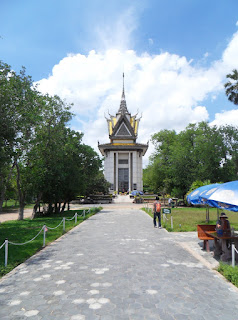Phnom Penh is the capital of Cambodia and the smallest capital so far on our travels. With a plane to catch we planned only two days to see the main sites and prepare for our next and final country in Asia. With an extremely limited public transport system there are few options to get you around the city, so we hired a TukTuk to see two of the three sites on our hit list.
Unfortunately, Cambodia is only really famous for two things, Angkor Wat and the Khmer Rouge and the atrocities forced upon its people during the short reign of Pol Pot.
The simple but chillingly titled S-21 was originally a school that was converted in 1975 into a interrogation and torture centre located in the centre of Penom Penh. The Khmer Rouge governed the country for 3 years and this facility was used to process more than 20,000 teachers, intellectuals, politicians, actors, artists and anyone who disagreed with their plans for the country. So scared of reprisals from remaining families members and children of incarcerated people, Pol Pot also ordered their execution.
The facility and the genocide was discovered in 1978 when the Khmer Rouge were finally overthrown by Vietnamese and exiled Cambodian’s. It was immediately locked down and has been left as it was found.
The building is now a museum dedicated to explaining what happened and to put a human face to those that died at the hands of the Pol Pot regime. Throughout the building are displays of the hundreds of pictures taken by the soldiers of the people incarcerated at S-21, before and after interrogation. The first room we entered was to set the scene for the rest of the museum. A small, tiled floor room very dilapidated with bars on the windows and in the centre was a metal bed with no mattress and leg irons. On the wall was a large picture of such a badly beaten person you could not make out whether it was male or female. As you looked around at the floors, walls and ceiling you began to notice other marks and stains. It soon became clear that these were blood splatters from the interrogations that had taken place here. We found out that the picture on the wall was one of 14 bodies they found when the facility was captured and the picture was taken to show exactly how they had been found. Thirteen other rooms bore similar pictures hung in similarly stained surroundings. As you can imagine this was extremely disturbing and upsetting.
The picture below shows the list of security regulations for those detained within its walls.
Those that did not die at S-21 (many did) were taken to Choeung Ek or (as it is now known) the Killing Fields to be executed. Some 16 km outside the city it occupies a 500m x 500m square of land just off a main road and once was a Chinese cemetery.
The site contains a large number of mass graves burying 17,000 men, women and children. The site contains a small museum and a large 38m tall glass tower containing the 8,985 exhumed bodies. The tower is arranged by body part, with clothes and skulls at the bottom and hips, legs, and even teeth arranged on separate platforms all the way to the top. The rest of the site is open for you to wander around with small dirt tracks marking your way between the large holes that once were the graves. As you walk round the site you begin to see rubbish everywhere but upon closer inspection you realise that what you are walking on are the clothes and bones of the people buried at the site coming to the surface due to erosion. Some areas have been roped off and these are where the forensic investigators exhumed the bodies that are now contained in the tower. The final roped off pit also had a large tree oak beside it and this was used to kill the 100 children and babies who died here (the method of death being truly sick and unthinkable to repeat here).
As you would imagine, the site had a very eerie feel about it and as you walked around no one spoke. Even though the site was next to houses and a major road I cannot remember hearing a single sound during our time there. This could just be that of the brain turning off your hearing to be able to begin to comprehend the awfulness of what you are seeing.
We returned to the hostel in a sombre mood and for a very stiff drink. For both of us it’s a day we will not forget in a hurry.
We deliberated before going to these sites whether it was appropriate to visit such places but on a leaflet handed to us at the gate of S-21 the words below help put into perspective why they have been kept the way they are and why people should visit.
“Keeping the memory of the atrocities committed on Cambodian soil alive is the key to building a new and strong state. Further, making the crimes of the inhuman regime of Khmer Rough public plays a crucial role in preventing a new Pol Pot from emerging in the lands of Angkor or anywhere on earth”
Next: Malaysia and Kuala Lumpur.
Friday, 25 June 2010
Subscribe to:
Post Comments (Atom)







No comments:
Post a Comment